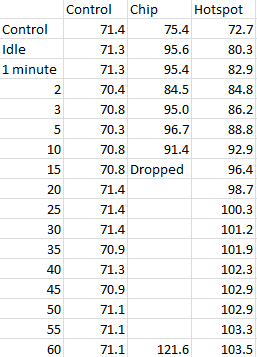Good Morning from my Robotics Lab! This is Shadow_8472, and today, I am rerunning the experiment from a few months ago to see if my Raspberry Pi is likely to melt through its PLA casing. Let’s get started!
Last time, my apparatus failed miserably. The painter’s tape holding the thermal probe in place slipped just enough to let the probe get away from the point it was supposed to be measuring. This time, I used Scotch tape, and it held. Another improvement was a custom program that ran all the CPU’s cores at 100%, compliments of the workshop I’ve been going to. I recorded temperatures to the nearest tenth of a degree instead of rounding to the nearest whole.

I ran the experiment for an hour, taking measurements on a white envelope on my desk, a chip on the upward facing bottom of the Pi, and the probe measuring the target spot on the case. Measurements were taken while it was off, after the Pi had been running long enough to level off the critical spot’s temperature, and every five minutes after the test started, with extra data points at 1, 2, and 3 minutes.
I changed procedure at the 15 minute measurement, as the temperature from the chip was highly unstable, likely due to temporarily improved ventilation by removing the case’s head. After dropping this measurement, I noticed the probe temperature climb from slightly faster before stabilizing to within a degree of 102 F for the second half hour of the test, well below the glassing temperature of PLA.
Conclusion: While this case should be fine with whatever load I put on it, PLA is not the material to be making computer cases out of.
Final Question: Have you ever changed an experiment mid-procedure because you suspected your measurements were affecting your results?

